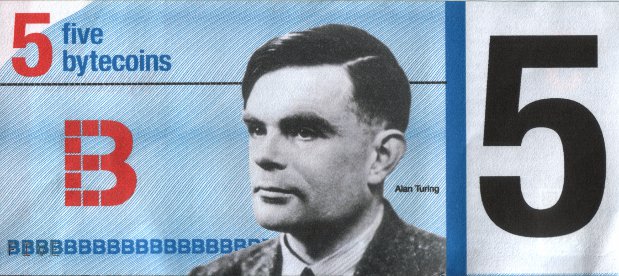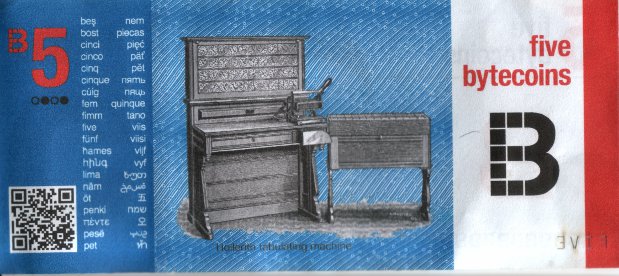by Javantea
July 2-5, 2011
While bitcoins are getting a lot of press, I thought I would pimp an even newer currency that has been circulating through the Seattle Hacker scene. Bytecoin [1], not to be confused with Bitbills [2] or Bitcoins [3] are a paper currency with no crypto security features. That means that in order to counterfeit a bytecoin, you simply need to copy it perfectly. On the other hand, bytecoins are cool, pretty, and worth the paper and ink they are printed on. Being real-world counts for something. I procured a sample and scanned it with my old scanner and made a 1450 dpi copy of the front and back of the 5 bytecoin to show the craftmanship of the bill. Of course, with a decent printer, you could use this image to counterfeit the currency as well. Time will tell whether bytecoins become worthy of counterfeiting, but I feel that the currency is worth something. The fact that I am posting hi-res scans means that the bytecoin is worth something to me. I am grateful to the author who was willing to let me post these scans.
The question I would like to ask is: what can we do with bytecoins? The obvious problem with bitcoins is that they are overvalued. As they become more overvalued, they become more scarce. With bytecoins, this should not happen because they are counterfeitable. Those who end up printing them and passing them as the real thing will be able to inflate the market which will devalue the currency. Knowing this people are much less likely to offer goods and services in exchange for bytecoins. However, this has not stopped people from trading, selling, and discussing bytecoins. In fact, every chance I get I will discuss counterfeiting of bytecoins and someone will bring up the worth of the currency.
Matt Westervelt has rumored that the higher denominations of bytecoins will be protected with glow in the dark ink. This makes the larger bills worth more but does not change the problem of the small denominations.
What is the value of a piece of paper with carefully printed data on it? I say that the person who gives it to you is the decider of the price. This concept is called reputational currency. Cory Doctorow described this concept in his novel Down and Out in the Magical Kingdom and Bruce Schneier described it in his novel Distraction. If you apply this concept to the bytecoin you can think of a 5 bytecoin as being a stock purchase from a person who had reputation in the bytecoin network. A person in the bytecoin network will sell these only to people who have reputation or worthy trade. When a person counterfeits a bytecoin, it will not be entirely apparent to someone who is not in the bytecoin network, so they will be swindled. A person who has seen a bytecoin will probably see the difference between a counterfeit and a real one and not value the counterfeit as much as the person who holds it. If a perfect counterfeit is created, the person who creates it has the ability to fool people who are in the bytecoin network, but as long as the network is small enough, a counterfeit bill will be difficult to pass. If the bytecoin network ever grows to the size that a perfect counterfeit bill could be passed, that would bring the value of the currency to the price it takes to print. As we all know, a currency that is worth only as much as the paper and ink it is printed with is doomed. It is difficult to solve this problem and I submit the task to crypto-currency people: how do you stop counterfeiting without requiring the complexity and inherent vulnerability of a consensus system? [4]
In 2005, I came up with a very simple reputational currency called Sand Credit [5] that used SSL client certificates, SHA1 hashes, and a web of trust to decide the value of a person's account at any given time. It has limitations, but is generally sound for the purpose of trading something of obvious value for something of unknown value. In order to take payment for something of value, you calculate what a person's currency is valued at by how many debts you owe to people who owe that person. Without debt, you are essentially taking someone's word that their network will provide you with something of value in the future. An attacker in this system would not be able to get credit easily. In the worst case scenario he would be able to steal one item before being banned. The next pseudonym account created would be blank and more likely to be rejected for credit. This system is resistant to counterfeit because it uses debt to calculate value.
If you'd like to tip me for this blog, I accept bitcoins, bytecoins, and many other currencies, though I don't value them as much as your two cents.
- Filer, Andy. "Five-bytecoin note". URL: http://afiler.com/five-bytecoin-note/
- Qugel LLC. Bitbills. URL: http://bitbills.com/
- Bitcoin Project. Bitcoin. URL: http://bitcoin.org/
- Laurie, Ben. "Decentralised Currencies Are Probably Impossible (But Let’s At Least Make Them Efficient)". URL: http://www.links.org/?p=1179
- Javantea. Sand Credit. URL: https://www.altsci.com/sandc/
-
Leave a Reply







Comments: 0
Leave a reply »